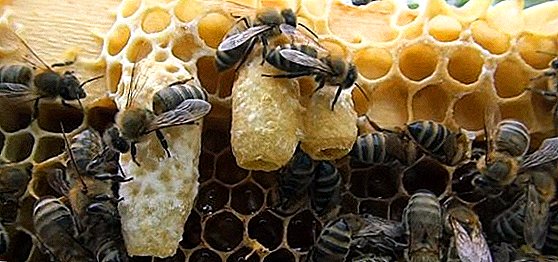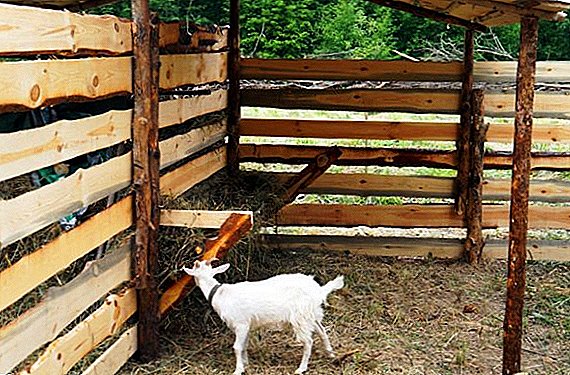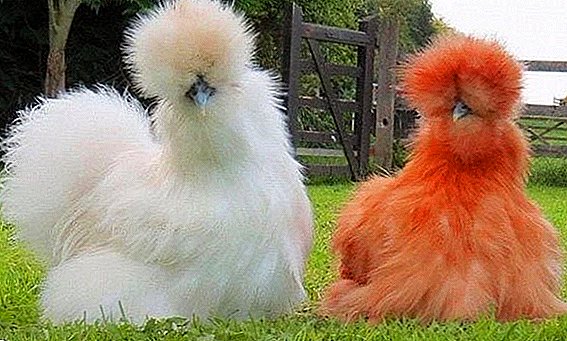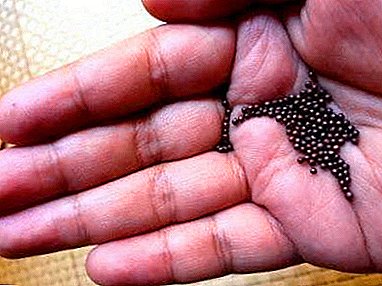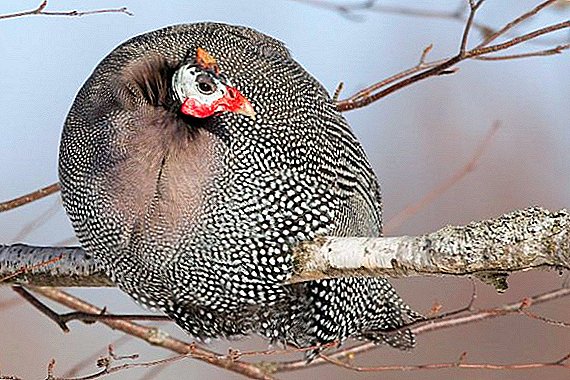 Carpentry is very common abroad, where dietary meat and egg products are highly valued. In addition, guinea fowls are beneficial in terms of content. They do not give the farmer troubles, practically do not get sick and quickly adapt to any conditions. And broiler species are also distinguished by high productivity. What is this variety, how to care for it, what to feed it and where to contain it will be discussed later in the article.
Carpentry is very common abroad, where dietary meat and egg products are highly valued. In addition, guinea fowls are beneficial in terms of content. They do not give the farmer troubles, practically do not get sick and quickly adapt to any conditions. And broiler species are also distinguished by high productivity. What is this variety, how to care for it, what to feed it and where to contain it will be discussed later in the article.
What is a broiler chicken guinea fowl
Broiler breeds of any bird are always easy to recognize by their meaty body, large size and specific behavior.
Did you know? The first to learn about the existence of wild guinea fowl were South African tribes. And in the V century BC. e. This bird was discovered by the ancient Greeks and Romans, who praised it to the sacred level. Since then, the fame of the colorful birds has spread to the very West Asia and Byzantium. It was a very expensive animal, which only wealthy individuals could afford.
This type of guinea fowl is the fruit of persistent and long-lasting work of breeders, who in the end sought to obtain a highly productive bird with strong immunity, high resistance to adverse environmental factors and satisfactory survival rates. 
Description and appearance
Broiler guinea fowls from a distance are visible to their alluring pearl plumage. Depending on the breed, it may be white, gray-blue, smoky with thick white specks and completely covers the whole body.
You will certainly be useful to know the characteristics and lifestyle of an ordinary guinea fowl.
The selection of this bird is characterized by a large constitution and muscular body. From the wild ancestors they inherited:
- well developed powerful paws of gray color;
- small strong wings rounded shape;
- long naked neck, smoothly turning into the torso;
- medium sized hook-shaped beak;
- rounded back;
- short tail with thick lower pubescence;
- fleshy hairless beard;
- leathery red-and-white catkins hanging from both sides of the non-pendent head;
- bright leathery growths on the crown and under the neck.
 In some breeds, the outward signs may be completely different from the standard with a variegated feather, multi-colored ear rings, or the presence of a tuft on the crown.
In some breeds, the outward signs may be completely different from the standard with a variegated feather, multi-colored ear rings, or the presence of a tuft on the crown.This living creature leads a herd life and, despite its tameness, continues to be semi-ardent. She is friendly with all the inhabitants of the house, but keeps away from them.
In everyday life, the guinea fowl shows enviable endurance and cold resistance. It can be kept both in the pen and in the open aviary. The only disadvantage of pearl exotism is poorly developed maternal instinct. 
Productivity
Guinea fowls have the following productive characteristics:
- For slaughter, this animal is already suitable at five months of age. By this period, females weigh about 1.5 kg, and males weigh 200 g more. The maximum weight of broilers does not exceed 3.5 kg.
- For every kilogram of growth, the annual feed consumption is about 2.8 kg.
- In addition, the bird is characterized by rather high egg-laying rates. For a year, a hen, depending on the characteristics of the cross, gives about 120-150 eggs, each of which weighs 45-50 g on average. They differ from the chicken in a creamy dense shell with small white specks. According to the content of nutrients and vitamins, the eggs of the hen-broilers are leading in the ranking of the most useful antiallergenic diet products.

Types of broiler chickens
In modern zoology, the concept of the guinea fowl unites about 20 species of birds from different genera of the Fazanov family. Many of them are involved in the emergence of broiler breeds, which today are represented in the widest range. Consider the most popular of them.
We advise you to consider all the features of the most popular wild and domestic breeds of guinea fowl, and in particular the guinea fowl of the Zagorskaya white-breast.
French (Gray-speckled)
The variety comes from France and is distinguished by a smoky-speckled plumage, a fleshy large body, as well as a short tail dipped down. These hybrids have a small, bare head with a bluish fleshy growth under the beak, an elegant long neck and a vertically set body.
Thanks to well-developed muscular wings, they can easily fly up to great heights. Therefore, experienced breeders advise cutting down feathers in the young.  The breed is in demand with many farmers and today holds the lead in popularity rating. This is due to the high rates of meat and egg products. Mature individuals weigh about 3 kg. During the year, females inflict up to 150 eggs weighing 50 g each. The fillet portion of a French broiler is characterized by a dark bluish tinge that brightens when cooked. It tastes very close to game.
The breed is in demand with many farmers and today holds the lead in popularity rating. This is due to the high rates of meat and egg products. Mature individuals weigh about 3 kg. During the year, females inflict up to 150 eggs weighing 50 g each. The fillet portion of a French broiler is characterized by a dark bluish tinge that brightens when cooked. It tastes very close to game.
Zagorsky white-breasted
This species, like the traditional guinea fowls, is characterized by the speckled coloring of the majority of the plumage and the luxuriant white sternum, which smoothly passes over to the neck and abdomen. The feather in pedigree specimens is characterized by friability and increased fluffiness.
Did you know? Guinea fowl, like geese, begin to heart-rending with the whole herd at the sight of danger: dogs, cats or even a stranger. Sometimes these birds scream when they break away from the flock, and also to show their dominant to the rest of the inhabitants of the house.The meat of the Zagorsk white-breasted guinea fowl is almost the same in taste as the traditional species of this bird. Due to the small amount of fat in the composition, it also has a darkish bluish tint, which affects the presentation of the carcasses. By the age of 10 months, the male weighs about 2 kg, and the hen gives up to 140 eggs per year.
 In size and productivity, these crosses are slightly inferior to their French counterparts.
In size and productivity, these crosses are slightly inferior to their French counterparts.Siberian white
Siberian broilers are distinguished by their pure-white color of feathers, as well as bright red earrings, beard and paws. These parts of the body look very contrasting, attracting attention to themselves. The bird has strong immunity, tolerates cold, heat, quickly adapts to new conditions of detention and is completely unpretentious in food.
Broiler breeds of guinea fowls are bred for dietary meat. Read about the benefits of guinea fowl.
Representatives of this breed are growing rapidly. Mature males weigh about 2 kg. And females, in addition, are characterized by high egg production rates. For the year they put up to 150 eggs with an average weight of 50 g. 
Cream (Suede)
This broiler breed, as well as Siberian white, has no bright signs of appearance. It is characterized by a monotone pale pink shade of a feather and reddish leathery areas of the body.
Did you know? Due to the duration of storage, hen's eggs were indispensable in the diet of sailors and travelers. They are also regularly taken on expeditions by American polar explorers.
Productivity indicators, compared with the above hybrids, suede guinea fowls are the lowest. Mature individuals weigh 1.5 kg and produce no more than 110 eggs per year with an average weight of 42 g. 
Content Features
Guinea fowl hybrids are beneficial in maintenance, as they graze well, are picky in feed, are friendly and can provide for themselves comfort. The productivity of exotic birds largely depends on the conditions of stay. To increase it, the experienced tsarsarkovy advise to properly equip the house and systematically care for it. How to do this, we will describe in detail below.
Consider all the features of the content of guinea fowls at home, and in particular in the winter.
Room Requirements
Pearl birds appreciate free space and at the same time like cozy corrals. Therefore, the breeder should take care of the presence of a warm poultry house and barred aviary in advance, otherwise his wards will get used to spend the night in the trees and soon run wild.  The premises and the walking area for guinea fowls are settled with the following nuances:
The premises and the walking area for guinea fowls are settled with the following nuances:
- on each square meter in the bird's house should be no more than 2 adults;
- newborn babies in a similar area can be planted up to a dozen;
- the room must be ventilated daily, because exotics do not tolerate stagnant air;
- inside the hen house, in the accessibility zone, drinkers and feeders are placed, and perches and nests are also arranged;
- the floor is covered with deep straw or peat bedding, and river sand is used for chickens;
- territory walking plan based on the fact that 1 square should fall 30 square meters of space;
- The enclosure must be tightened to a two-meter height by a net;
- in the place reserved for guinea fowls, shrubs and other vegetation are very desirable, which will help create an atmosphere of the range.

Care rules
Caring for broilers of hens is not much different from the content of chickens. In this aspect, the poultry farmer should regularly plan the following activities:
- once a year, the house needs a general cleaning, which includes the removal of litter, washing and disinfecting the floor, whitewashing the walls;
- in the winter, every 3-4 days the litter should be renewed, sprinkling the old layer;
- even in the bird house, where pearl birds are kept, there is no fetid odor, you still need to ventilate the room;
- in the heat, change the water in the drinking troughs twice a day and wash them daily;
- 3 times a day at the same time to feed the wards, after cleaning the feeders from the remnants of the previous feeding;
- make sure that in winter the temperature in the hen house does not fall below +12 degrees Celsius, and the air humidity corresponds to 65-70%;
- in the period of daylight reduction, in order to improve the egg production of laying hens it is necessary to ensure the daily operation of the lamps from 7 am to 10 pm.
 One of the conditions for increasing the egg production of chicken - lighting the room
One of the conditions for increasing the egg production of chicken - lighting the roomWhat to feed the birds
Guinea fowl are very specific birds, as they can take care of food on their own. They graze well, collect all kinds of insects, and also hunt small reptiles and rodents. But relying on the wild instincts of self-preservation wards are not worth it. From the first days they need to be taught to organize feeding at the same time.
Important! Guinea fowl meat never causes allergies, which is of particular importance for pregnant women, nursing mothers and babies.
And taking into account the main goal of broiler breeding, which consists in intensive meat buildup, the nutritional diet of birds should consist of various components rich in minerals and vitamins. Let's see what is possible and what cannot be given to adults and young animals.  Guinea fowls alone can take care of food
Guinea fowls alone can take care of food
Adult guinea fowls
These exotic birds eat absolutely everything. But for their successful breeding diet should be balanced. Ideally, it consists of the following products:
- oats - 20 g;
- barley - 20 g;
- corn - 21 g (grain component can be replaced with food waste in the form of boiled potatoes, cereals, cottage cheese);
- wheat bran - 20 g;
- fish meal - 5 g;
- raw carrots - 20 g (the component is very important because it is the main source of retinol and keratin, although it is eaten reluctantly);
- clover, alfalfa, meadow grass mixture, cabbage leaves, quinoa, nettle, young birch leaves, dandelions, burdock tops - 25 g;
- chopped needles from spruce - 15 g;
- yeast - 6 g (significantly increase the performance of egg-laying);
- fish oil, waste or boiled chopped meat - 3 g (entered only in cases when pets are unable to forage in the garden or on the meadow, where one can catch enough worms, mice, slugs and frogs);
- table salt - 0.3 g;
- fresh greens - 50 g (with free-run wards fully satisfy their needs for this ingredient, it is undesirable to give sluggish or coarse grass);
- mineral feeds (small fractions of gravel, crushed chalk, crushed seashell of sea or freshwater origin, wood ash, large river sand);
- feed - 50 g (it is advisable to feed dry);
- Meal - 10 g (additive is relevant in case of deficiency of proteins).
 It is recommended to feed mature birds at 7, 12 and 18 hours. In addition, it is important to change the water in the water in a timely manner.
It is recommended to feed mature birds at 7, 12 and 18 hours. In addition, it is important to change the water in the water in a timely manner.Important! The annual need for an adult guinea fowl in grain feeds should be considered equal to 33-36 kg. In winter, guinea fowls, if they are in a warm room, 76 g of grain feed and 3-4 g of animals (per day per head) are sufficient.
Youngsters
The food of the czar is much like a chicken diet. The only difference is in the recommended daily protein intake, which should be 24% of the total feed. As the chicks mature, this figure is reduced to 17%. For the full development of young, in his diet is administered:
- wheat bran (given from the first day of life, starting from 1 g, gradually increasing to 10 g by the 90-day age);
- hard-boiled chicken egg (recommended in the first week of life);
- milk crumbs dipped in milk;
- ground corn kernels (can be given to newborns, starting from 1.8 g and bringing the portion to the 50th day of life to the maximum 4.6 g);
- seed oat flour (from a gram portion to the 120th day of life, the portion grows to 13.5 g);
- wheat flour (veterinarians are advised to add 3 grams of this component in 2.5 months);
- millet (at 5.7 g give only from the 59th day of life, gradually increasing the daily rate to 20.7 g);
- ground barley kernels (introduced into the diet at three months of age with a daily portion of 4.2 g);
- fish meal (given from the first day to 1-3 g);
- sour milk (useful as a first complementary food at a dosage of 3 g, gradually increasing the daily rate to 14 g);
- fresh greens (newly hatched chicks finely chop dandelions and alfalfa);
- clover hay (recommended for 13.3 g from 3 months of age);
- Baker's yeast (you can give 1-2 g from 40 days of life).
 Nestlings, like adult guinea fowls, should eat 3 times a day. Intensive fattening should be practiced from the age of three months.
Nestlings, like adult guinea fowls, should eat 3 times a day. Intensive fattening should be practiced from the age of three months.Poultry farmers should be familiar with the intricacies of breeding guinea fowl in an incubator, as well as learn how to care for guinea fowl.
Breeding broiler chickens
Properly organize breeding guinea fowls will help the following tips:
- It is necessary to release wards from the house, after they are demolished. This is done so that the half-feral bird becomes accustomed to its abode and independently returns home after walking. When systematically feeding at the same time, pets rush to the feeders, and then again run up to pasture.
- Numerous experiments with the breeding of hybrid breeds have shown that broiler guinea fowls do not need "greenhouse conditions". For their comfort, a rather cozy pen and a spacious aviary. Experienced breeders advise to grow meat birds to three months of age, since from that time they sharply stop their growth.
- Even beginning poultry farmers will be able to cope with the breeding of guinea fowl in home gardens. Pets quickly get used to people who care for them, and very noisy meet strangers. They are not overly shy and blindly trust the leader of their herd. In the yard they never show aggression towards other animals.
- Like chickens, these birds love to rummage in the ground in search of insects and worms, so you can dig up a small area in the aviary, as well as pour a pile of river sand or wood ash nearby. Birds will be very happy to have such baths.
- Sometimes there are cases when several birds manage to fly a fence. Characteristically, they never run away and tend to go back. To catch them, you need to create the appearance of imminent danger. Then the birds concentrate their attention only on the potential enemy and forget about the environment.
 It is very profitable to breed broiler guinea fowls because these birds are a source of useful and nutritious meat and egg products, recognized worldwide as a dietary delicacy. We hope our advice will help you to create a comfortable environment for pets and organize competent care for them.
It is very profitable to breed broiler guinea fowls because these birds are a source of useful and nutritious meat and egg products, recognized worldwide as a dietary delicacy. We hope our advice will help you to create a comfortable environment for pets and organize competent care for them.

